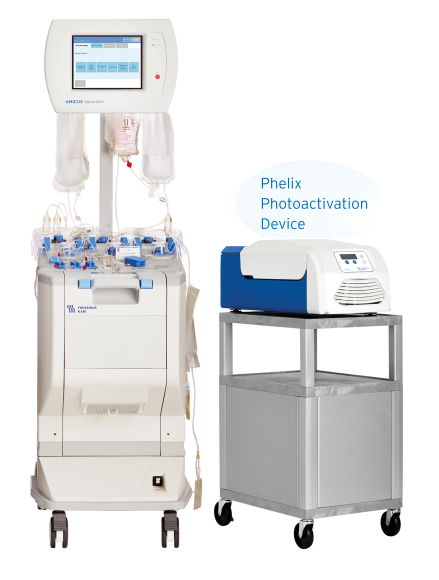- MNC - High MNC collection efficiency with low platelet loss, flexible controls allow MNC settings to be adjusted quickly. Automated custom prime option for patients with lower total blood volume or lower hematocrit.
- TPE – High efficiency in plasma removal, meaning less anticoagulant (AC) to the patient. Accurate control of liquid balance with real-time volume measurement and automatic bag change for the replacement liquid. Supports patient comfort with low extracorporeal volume.
- RBCx – Three different procedural options including RBC exchange, RBC depletion and RBC depletion/exchange.
- Platelets - Focused on donor comfort and safety. Highly efficient platelet collection function with simultaneous plasma and erythrocyte collection options and automatic PAS (Platelet Additive Solution) function.
- ECP - The Extracorporeal Photopheresis protocol is an advanced procedure for the Amicus Separator that combines the Amicus MNC collection technology and the Phelix photoactivation device. After photoactivation, Amicus reinfuses the photoactivated cells into the patient.*
Focused on Patient safety and comfort
- One kit for single needle or double needle access
- Low extracorporeal kit volume (163 ml)
- Low minimum patient hematocrit (15%)
- Process up to 8 litres of whole blood in 2 equal volume cycles
- Qualified for use with ACD-A
- Automated Custom Prime for patients having a lower total blood volume and/or lower hematocrit
- The needle-free 8-MOP1 injection site contains a 0.2-micron antimicrobial filter combined with a one-way valve, creating a functionally closed pathway in the disposable kit
- Patient saline option administers saline to keep access lines open
- Real-time fluid balance tracking
- Disposable kit irradiation sterilised to prevent the risk of patient reactions when compared with ethylene oxide sterilisation.
Seamlessly connected – DXT©
- Amicus runs our proprietary software application designed to receive, store and transmit procedure information between Fresenius Kabi apheresis devices and external computer systems (ECS).
- Allows for bi-directional transmission of electronic procedure record
- Dashboard and Reporting data
- Automatic printing of stored procedure records
